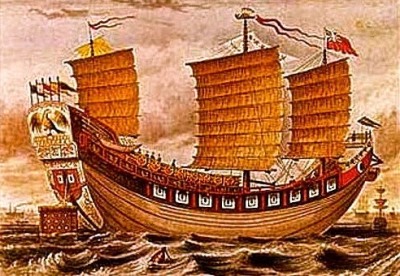During the period that the sailing ship was developing in the Mediterranean world, China, with its vast land areas and poor road communications, was turning to water for transportation. Starting with a dugout canoe, the Chinese joined two canoes with planking, forming a square punt, or raft. Next, the side, bow, and stern were built up with planking to form a large, flat-bottomed wooden box. The bow was sharpened with a wedge-shaped addition below the waterline. At the stern, instead of merely hanging a steering oar over one side as did the Western ships, Chinese shipbuilders contrived a watertight box, extending through the deck and bottom, that allowed the steering oar or rudder to be placed on the centreline, thus giving better control. The stern was built to a high, small platform at the stern deck, later called a castle in the West, so that, in a following sea, the ship would remain dry. Thus, in spite of what to Western eyes seemed an ungainly figure, the “Chinese junk” was an excellent hull for seaworthiness as well as for beaching in shoal (shallow) water. The principal advantage, however, not apparent from an external view, was great structural rigidity. In order to support the side and the bow planking, the Chinese used solid planked walls (bulkheads), running both longitudinally and transversely and dividing the ship into 12 or more compartments. This produced not only strength but also protection against damage.
In rigging the Chinese junk was far ahead of Western ships, with sails made of narrow panels, each tied to a sheet (line) at each end so that the force of the wind could be taken in many lines rather than on the mast alone. Also, the sail could be hauled about to permit the ship to sail somewhat into the wind. By the 15th century junks had developed into the largest, strongest, and most seaworthy ships in the world. Not until about the 19th century did Western ships catch up in performance.
